

Convicts - First Fleet Fellowship Victoria Inc. First Fleet Online - ltcprd. Index to early convict records. Early indents provide name, date and place of trial and sentence while the later indents usually contain more information such as a physical description, native place, age and crime.
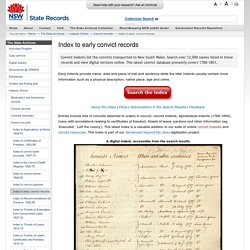
About the Index | FAQs | Abbreviations in the Search Results | Feedback Entries include lists of convicts attached to orders in council, convict indents, alphabetical indents (1788-1800), many with annotations relating to certificates of freedom, tickets of leave, pardons and other information (eg. ‘Executed’, ‘Left the colony’). This latest index is a valuable addition to our suite of online convict indexes and convict resources. This index is part of our Sentenced beyond the Seas digitisation project. ABC online education. First Fleet - Stories. First Fleet Convicts Register. Convicts of the First Fleet. Acknowledgement: Newspaper article transcribed in 1992 by Barbara Turner.
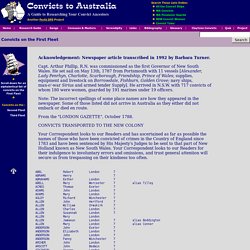
Capt. Arthur Phillip, R.N. was commissioned as the first Governor of New South Wales. He set sail on May 13th, 1787 from Portsmouth with 11 vessels [Alexander, Lady Penrhyn, Charlotte, Scarborough, Friendship, Prince of Wales; supplies, equipment and livestock on Borrowdale, Fishburn, Golden Grove; navy ships, man-o'-war Sirius and armed tender Supply].
He arrived in N.S.W. with 717 convicts of whom 180 were women, guarded by 191 marines under 19 officers. Note: The incorrect spellings of some place names are how they appeared in the newspaper. From the "LONDON GAZETTE", October 1788. Your Correspondent looks to our Readers and has ascertained as far as possible the names of those who have been convicted of crimes in the Country of England since 1783 and have been sentenced by His Majesty's Judges to be sent to that part of New Holland known as New South Wales. Browse Convicts. Browse By Surname Browse convicts by their surname.

Select the first letter of the surname below to get started. Or Try A Search Just enter the name of the person you are searching for. If you prefer, try searching this website with a Google search. New Feature: Add a Convict! Convicts transported to Australia in 1787. State Library of New South Wales. The State Library holds the world's largest collection of original First Fleet journals and correspondence.
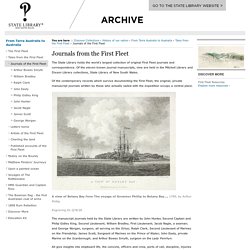
Convict life in The Rocks, Sydney - History (5,9) 00:00:11:21RICHARD GLOVER:Are you one of our regular students for Self Improvement Wednesday?
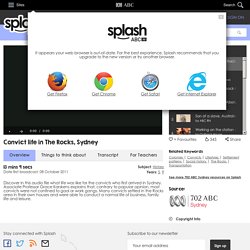
Each week, you get to learn something new and each week, you can test out what you've learnt on our website, where there's already a pop-up test all about today's lesson. Your lesson this week - Convict Secrets of the Rocks. Your teacher is Associate Professor Grace Karskens, Senior Lecturer in Australian History at the University of New South Wales. Grace, good afternoon.00:00:33:17GRACE KARSKENS:Hello, Richard.00:00:34:11RICHARD GLOVER:Could we start about the layout of this area, because people are familiar with these crooked lanes and flights of stairs everywhere.00:00:41:03GRACE KARSKENS:That's one of the nicest things about The Rocks.
If people know it at all, those crooked laneways and stairs linking, 'cause it's a very steep area. Settlement at Western Port. The British government's second attempt to establish a convict settlement in Port Phillip Bay took place in 1826.
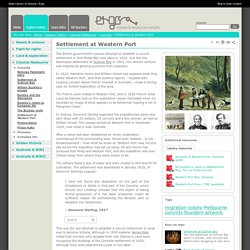
Just like the attempted settlement at Sullivan Bay in 1802, this second venture was inspired by glowing accounts from explorers. In 1824, Hamilton Hume and William Hovell had explored what they called ‘Western Port', and their positive reports – coupled with ongoing concern about French interest in Australia – made a strong case for further exploration of the area. Settlement at Sullivan Bay. In 1802, Lieutenant John Murray discovered Port Phillip and claimed the district for the Crown.

The British government was impressed with their positive reports, but were worried the French might try to establish colonies there. So the British decided to get in first. In April 1803, the HMS Calcutta and the transport ship Ocean sailed from England to establish a penal settlement at Port Phillip. Once they arrived, Lieutenant David Collins was responsible for over 450 people, including marines, free settlers and almost 300 prisoners. Life in the Factories - Convict Female Factories. Parramatta Female Factories and Staff.
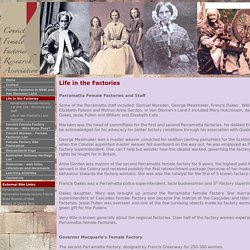
The Cook and the Curator. Breakfast at the barracks While Sydney’s ‘toffs’ tucked into a leisurely breakfast – anything from freshly laid eggs to kedgeree, smoked ham or cured tongue, sometimes as late as 11am, the convicts at the Hyde Park Barracks would have had to settle for a dish of dreaded hominy, a porridge made from maize, or corn meal, doled out in the mess halls just before dawn (see recipe below).

Already introduced to the harsh realities of convict life on Norfolk Island, John Knatchbull was aghast to find that conditions at the Hyde Park Barracks were far worse. A day in the life of a convict. Some hapless individuals experienced the full horrors of convict transportation.

It was no wonder that some, like Anderson, endured periods of mental instability. Navy seaman and thief Charles ‘Bony’ Anderson arrived in Sydney from Devonshire in 1834, aged 24. Convict slavery in Australia. Surviving: Way of life for British settlers, Settlement, 1788-1850, First Australians and the European Arrivals, SOSE: History Year 9, QLD. It was a struggle for the settlers to survive in the first years of the British colony in Australia.
They had come from a developed country with buildings, roads, shops and hospitals and arrived in a country that was entirely unfamiliar to them. Not only did they have to contend with strange plants and animals but the soil was also very poor and the climate much warmer and drier. State Library of New South Wales. Between 1788 and 1868, 165,000 convicts were transported to Australia. Transportation in New South Wales officially ceased in 1840, although there was a short-lived revival in 1849. During that period there were gradual changes in living conditions for the convicts. Under Governor Phillip and the early governors most convicts were employed on public works constructing roads, bridges and public buildings and cultivating government farms. Female convicts were generally employed as domestic servants to the officers. As the colony developed and free immigration increased, convicts were assigned to work for free settlers and small landholders.
Transportation - Victorian Crime and Punishment. The First Fleet. Home Our FREE ebooks Search Site.